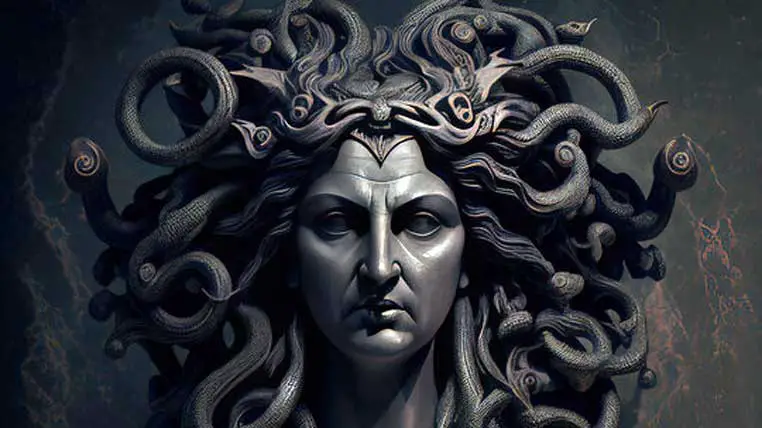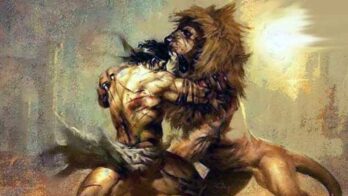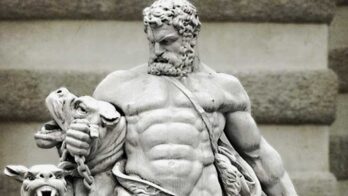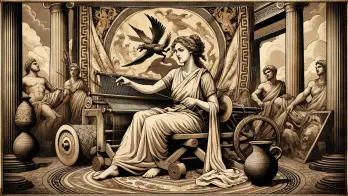Medusa was the daughter of the sea gods Phorcys and Ceto, and was the most fearsome of the three Gorgon sisters.
According to Greek mythology, anyone looking directly at her would immediately be turned into stone.
The mythological monster was often depicted as a half-woman, half-reptile creature with snakes for hair.
However, in the oldest versions of the myths, Medusa was portrayed as a stunningly beautiful girl and one of the lovers of Poseidon, the god of the seas and oceans in Greek mythology.
But the young girl offended the goddess Athena and was cursed by her to become a terrible creature, forever hunted by heroes in search of glory.
She was eventually killed by Perseus, one of the sons of Zeus. With the help of several Olympians, Perseus pursued her to her lair where, with great skill, he managed to avoid the creature’s magical gaze.
After a fierce battle, Perseus emerged victorious, killing the monster and taking her head as a trophy which he then used to defeat his enemies.
In the end, the severed head of Medusa ended up in possession of the goddess Athena, becoming part of the armor she wore in battle.
In some Greek myths and legends, Medusa is referred to as Gorgo.
How did the Greeks describe Medusa?
In most ancient sources, the Gorgon sisters were portrayed as terrifying.
For example, the poet Aeschylus, in the tragedy “Prometheus Bound,” written in the early 5th century BCE, speaks of the Gorgons as “the three winged sisters with snakes for hair, despised by mankind, whom no mortal could look upon and still draw breath.”
According to other sources, Medusa was “as beautiful as she was terrifying.” Pindar, a Greek poet who lived in the 5th century BC, described her as “a beautiful girl with white skin and rosy cheeks.”
In the “Theogony,” Hesiod does not mention anything about the physical appearance of the Gorgons, although the three sisters are mentioned several times.
Instead, in the “Odyssey,” Homer speaks of “the monsters’ heads,” and in the “Iliad,” the same author describes in detail the creature on the shield of the goddess Athena as “a monstrous Gorgon head, grim, giant, a thing of fear and horror.”
In the twelfth Pythian ode, the Greek poet and philosopher Pindar speaks of the “death-defying struggle of the fierce Gorgon,” the “snake-covered heads of the maidens,” and the head of “Medusa with beautiful cheeks.”
Later, during the Roman period, the Greek writer Apollodorus describes the three Gorgon sisters as having “heads with snakes coiled around them and large tusks like those of a pig, and bronze hands and golden wings that allowed them to fly; and all those who looked at them were turned into stone.”
In “Metamorphoses,” the poet Ovid reiterates the idea of the myth that Medusa was a gorgeous girl who was transformed into a hideous creature following a curse.
He tells how Medusa, a maiden with a beautiful face and enviable hair, was pursued by many suitors, but she refused them all.
What she did not know was that one of the suitors was none other than the sea god Neptune (Poseidon) in disguise.
Feeling humiliated by the young woman’s rejection, he lured her and raped her inside the temple of the goddess Minerva. Furious, the goddess punished Medusa severely, transforming her beautiful locks into venomous snakes.
As can be seen from numerous ancient myths and legends, many of the physical traits of the Gorgon sisters varied depending on the author or the region of origin of the stories.
The same was true for ancient Greek art.
The head of Medusa was a common feature of Greek ceramics, art, and architecture. However, there was a particularity.
While the Greeks preferred to paint their gods, heroes, and fantastic creatures in profile, Medusa was always portrayed from the front.
During the archaic period, between the 8th and 5th centuries BC, the motif of Medusa could be found primarily on the pediments and antefixes of temples, statues, and ceramics.
The image was always the same: a large, round face, snakes for hair, tusks, an open mouth, and a protruding tongue.
Genealogy
Parents
- Phorcys
- Ceto
Brothers
- Ladon
Sisters
- Stheno
- Euryale
- Graiae
- Echidna
- Hesperide
- Scylla
- Thoosa
Spouses/Lovers
- Poseidon
Children
- Chrysaor
- Pegasus
Most Greek myths and legends consider the sea deities Phorcys and Ceto as the parents of the three Gorgon sisters. It was also said that they were descendants of Gaia, the mother goddess of the earth.
According to other myths, the Gorgon was also the sister of the Hesperides; the dragon Ladon, who guarded the Garden of the Hesperides; the legendary monster Echidna, who was half-snake; and Thoosea, the mother of the cyclops Polyphemus.
The Gorgon and her family belonged to a primitive race of chthonic gods (gods associated with the earth, death, and the ancient world).
A monster herself, Medusa was also the ancestor of other mythological creatures, giving birth to the winged horse Pegasus and the giant Chrysaor.
The latter was the father of the three-headed monster Geryon, who was slain by the hero Heracles.
Myths and legends
One of the Gorgon sisters (the other two being Stheno and Euryale), Medusa was the only one of the three who was not immortal.
Perseus and Medusa
The Gorgon was killed by the hero Perseus, a demigod born to the god Zeus and the mortal princess Danae.
According to the legend, Polidectes, a cruel king who wanted to get rid of Perseus, asked the hero to bring him the head of Medusa.
In his attempt, Perseus was aided by several gods who gave him a shining shield made of gold, a pair of winged sandals, a helmet to make him invisible, a sword crafted by the god Hephaestus with which he slew Argus, and a magic bag to put Medusa’s head in.
Also, in this myth, we find a new description of Medusa, this time from the perspective of the god Hermes.
He describes her as follows:
The terrifying Gorgons have long, red arms of bronze; sharp steel claws; wings of gold, and on their heads hang tangles of bronze hair, in which many snakes are tangled.
Like those of a wild boar, their teeth are of a stunning whiteness, tearing apart any mortal who comes near them.
They have large, round eyes beneath their forehead. If they look at someone with their eyes gleaming with fury, that person turns to stone. Their bodies are covered with blue steel scales.
Those scales are so strong that no sword or spear could penetrate their flesh.
Perseus then flies to a white stone island in the middle of the sea. The Gorgons were just sleeping, and the snakes in their bronze hair moved sluggishly in their sleep.
The three creatures lay stretched out on a rock straight as a bed on silk sheets. And their blue, steel scales, red bronze claws, and long golden wings sparkled on the stone, almost blinding him.
Perseus rushed like a ghost next to the sleeping Gorgons. He approached them wisely, not looking at them directly, but reflecting them in his shining golden shield.
With his sharp sword, he cuts off Medusa’s hideous head with one stroke.
Then he grabs the bronze hair of her head and throws it into the bag. And with his foot, he pushes her body into the water, rolling.
The giant Chrysaor and the winged horse Pegasus
Medusa, one of the sea god’s wives, was said to have given birth to a horse from her severed neck. A horse with wings on its legs, named Pegasus by the Olympians and tamed by the hero Bellerophon.
While rising to the sky, Pegasus neighed. He neighed so loudly that it echoed to the sky. The immortal Gorgons, awakened by the noise, cried out in their bronze voices, terrified at the sight of Medusa in the waves.
According to other legends, also from the severed neck of Medusa, Chrysaor was born, a giant wielding a golden sword, who was the father of the three-headed giant Geryon.
The head of Medusa
After killing the creature, Perseus used the severed head as a weapon, turning his enemies into stone.
In Libya, he used the head of Medusa to kill the monster Cetus and save the beautiful Andromeda, who eventually became his wife.
When attacked by Phineus, Andromeda’s former fiancé, Perseus used the head of Medusa to turn him into stone. He did the same to King Polydectes, thus saving his mother, who was a prisoner of the tyrant.
Perseus encountered the titan Atlas in some myths, tasked with holding up the heavens. The two had a conflict, and Perseus forced the mighty titan to look at the head of Medusa. Atlas was turned into stone, and that’s how the Atlas mountains formed.
Finally, Perseus offered the severed head of Medusa to the goddess Athena, and she placed it on her shield (also known as the aegis). According to another tradition, however, the head was kept in Athens, buried under a mound of earth in the agora.
There are also some myths that speak of the medicinal and magical properties of Medusa’s blood. Therefore, according to Apollodorus, Asclepius used a vial of Gorgon blood from Athena to heal the sick.
Symbolism
Three sisters, three monsters from the Far West, with heads haloed with fierce snakes. Fangs of boars with bronze hands and golden wings spring from their lips. They are called Medusa, Euryale, and Stheno.
They are a symbol of the enemy that must be faced. The monstrous deformations of the psyche are due to the perverted forces of three impulses: sociability, sexuality, and spirituality.
Euryale represents sexual perversion, Stheno represents social perversion, while Medusa symbolizes the most important of these impulses: spiritual and evolutionary, perverted, however, in arrogant stagnation.
The guilt born of the arrogant exaltation of desires can only be combated by striving to fulfill the right measure, harmony. This could symbolize entering, as in a refuge, into the temple of Apollo, the god of harmony, when the Gorgons or the Furies pursue someone.
Whoever looked at the head of Medusa turned to stone.
Was it not because it reflected the image of their own guilt? However, the recognition of one’s mistake through exact self-knowledge can become perverted into maladaptive exasperation, into a scrupulous and paralyzing conscience.
Questions and answers about Medusa
Where did Medusa live?
According to the poet Hesiod (7th century BC), the three Gorgon sisters could be found “beyond the glorious Ocean, in the realm at the border between day and night.”
According to other sources, the three legendary creatures lived in today’s Libya. Other ancient authors have proposed even fantastic areas and territories, such as the mysterious Gorgonian fields of Cisthene in Asia Minor or the island of Sarpedon.
What did Medusa look like?
In ancient art, Medusa was represented as a woman with snakes in her hair, sometimes with wings and sometimes with fangs and powerful claws.
The ancient writers also described her as having a terrifying appearance, capable of turning people to stone just by looking at them.
The snakes in her hair were considered a symbol of her power and a warning to those who dared to challenge her.
Who were Medusa’s parents?
According to Greek mythology, two sea deities, Phorcys and Ceto, descendants of the goddess Gaia, were the parents of the three Gorgons.
Who killed Medusa?
The Gorgon was slain by the Greek hero Perseus, son of Zeus and princess Danae.
What is the origin of Medusa’s powers to turn people to stone?
According to Greek mythology, Athena cursed the beautiful girl after she caught her and Poseidon in her temple. Athena transformed her beautiful hair into snakes and gave her the ability to turn people to stone as punishment.
Was Medusa always a monster, or was she human at one point?
In some versions of the myth, the Gorgon was a beautiful human woman and a priestess of Athena. However, after being raped by Poseidon in Athena’s temple, Athena cursed her and turned her into a monster.
What is the significance of Medusa’s head on Athena’s shield?
Medusa’s head is often depicted on Athena’s shield as a symbol of Athena’s power and protection. The image of the Gorgon’s head was believed to ward off evil and protect the shield’s bearer.
What role did Medusa play in ancient Greek art and culture?
The three Gorgons were a popular subject in ancient Greek art, often depicted as a fearsome monsters with snakes for hair. They were also a popular motif in Greek pottery, sculpture, and jewelry.
What is the legacy of Medusa in modern culture?
Medusa has been a source of inspiration for artists, writers, and filmmakers for centuries. She has been portrayed as a seductive femme fatale, a powerful feminist icon, and a terrifying monster. Her image has been used in fashion, tattoos, and other forms of popular culture.
What was Medusa’s curse and how did she become a Gorgon?
Medusa was once a beautiful woman cursed by the goddess Athena for violating her temple. She was transformed into a monstrous Gorgon with snakes for hair, a face that turned people to stone, and wings.
Why did Perseus kill Medusa?
King Polydectes sent Perseus to kill the monster as a way to get rid of him, thinking he would not return alive. Perseus succeeded in slaying the creature with the help of Athena and Hermes.
What happened to Medusa’s head after Perseus killed her?
After Perseus killed her, he used her head as a weapon against his enemies, as anyone who looked at it would turn to stone. Eventually, he gave it to the goddess Athena, who placed it on her shield, the aegis.
What role did Medusa play in Greek mythology?
Medusa was a well-known figure in Greek mythology, known for her terrifying appearance and deadly gaze. She was often used as a symbol of female power and danger, and her image was used on shields and in other forms of art and literature.
At Ancient Theory we only use trusted sources to document our articles. Such relevant sources include authentic documents, newspaper and magazine articles, established authors, or reputable websites.
- Medusa. britannica.com. [Source]
- Pierre Grimal - The Dictionary of Classical Mythology. Editura Wiley Blackwell, 1996.
- Edward Tripp - Crowell's Handbook of Classical Mythology. Editura Thomas Y. Crowell Co, 1970.
- Medusa. wikipedia.org. [Source]
- Medusa in Ancient Greek Art. metmuseum.org.
- Traci Regula - The Curse of Medusa From Greek Mythology. thoughtco.com.






